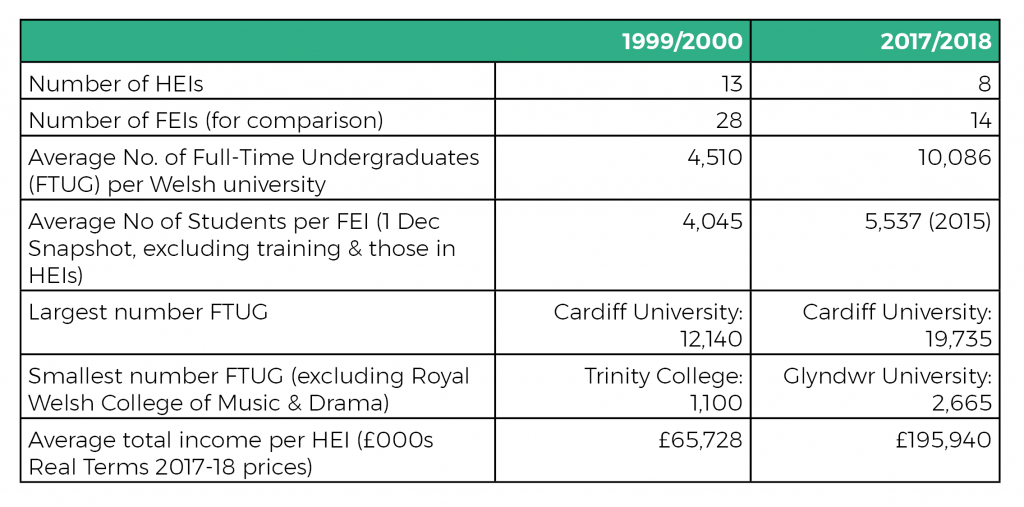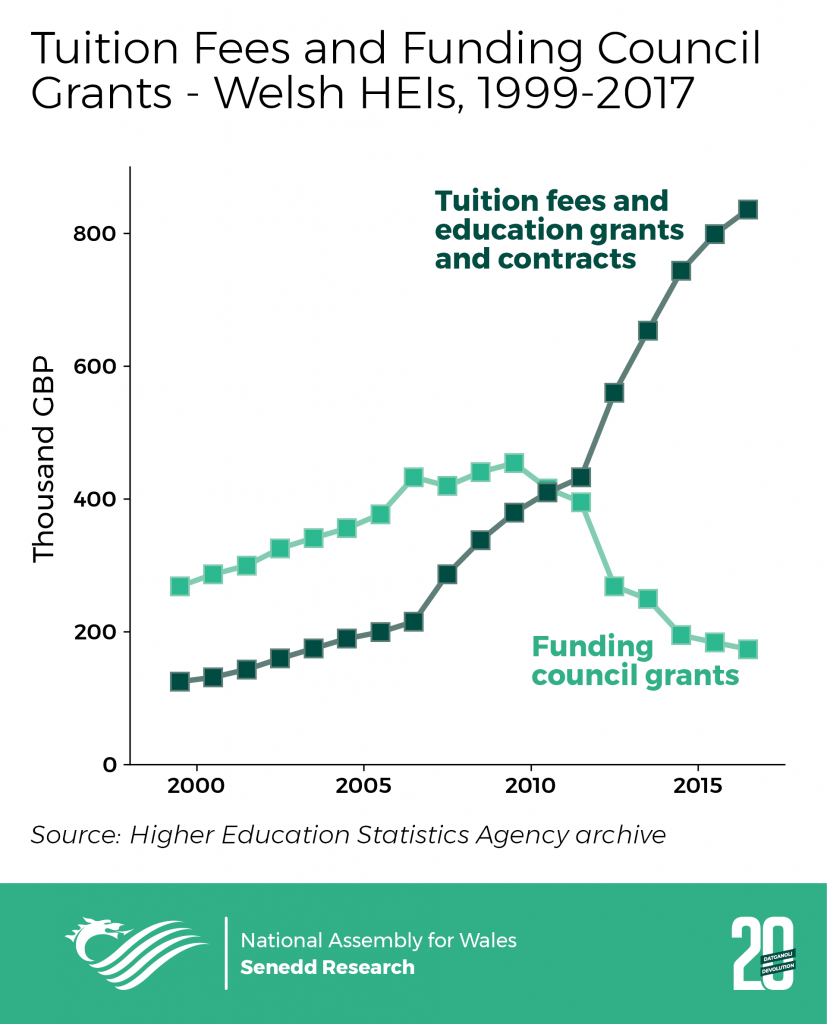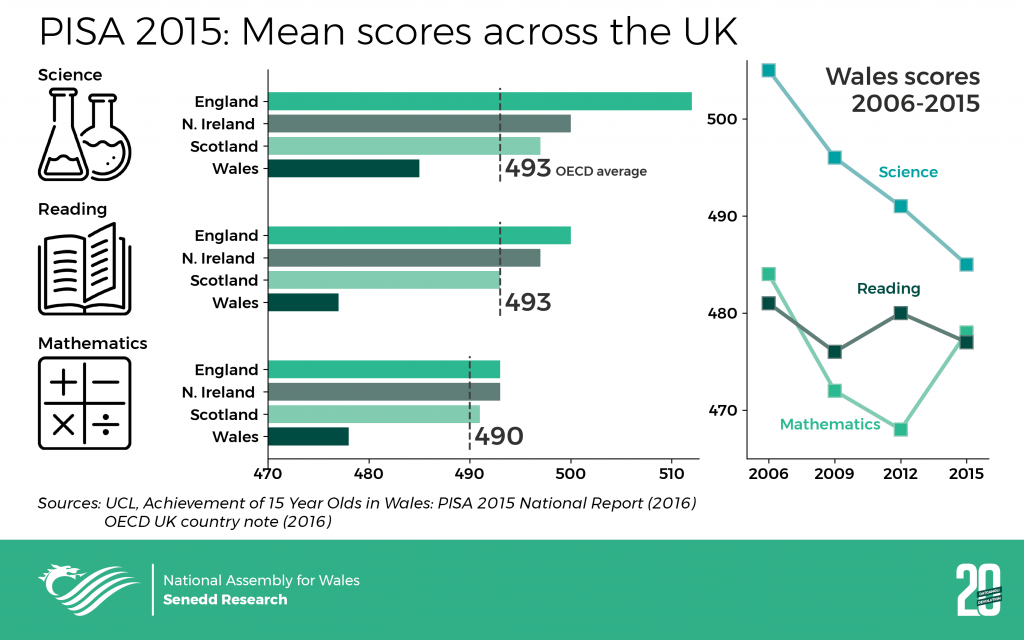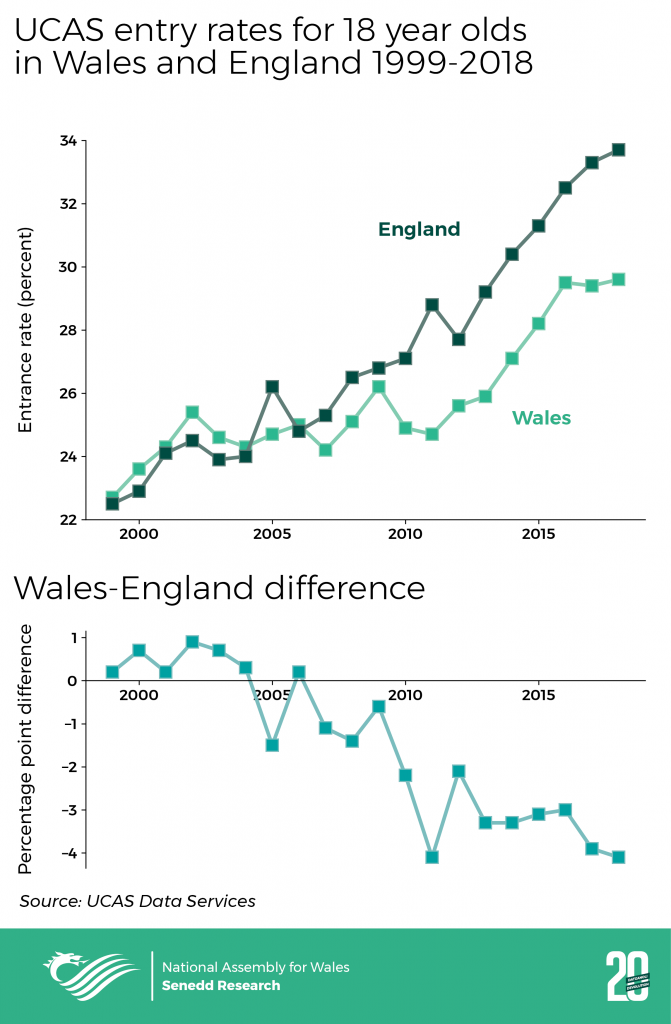Much has changed in Wales in the twenty years since the first National Assembly for Wales was elected in May 1999. This is the fourth in a series of articles that attempts to describe some of that change. It has been prepared by Senedd Research as part of the Assembly’s activity to mark twenty years of devolution.
Devolution has given policymakers the opportunity to develop a distinctly Welsh approach to education. In the early years of the Assembly, The Learning Country (2001) strategy was described as a “landmark document for those who hoped that the Welsh Assembly would not just nibble at the edges of educational policy-making but would also conjure up a wider vision of an education system to serve the Welsh nation” (Gareth Elwyn Jones & Gordon Wynne Roderick’s A History of Education in Wales (2003), cited in Philip Dixon’s Testing Times, 2016.)
Pre-16 education
A ‘made in Wales’ approach?
As part of former First Minister Rhodri Morgan’s 2002 declaration of “clear red water”, between Wales and England, the then Welsh Government ended Standard Attainment Tests (SATs) at Key Stages 1, 2 and 3. The publication of school-level pupil performance (often used to generate ‘school league tables’) also ended.
The Foundation Phase, which was introduced between 2004 and 2009, brought a new approach to young children’s learning, based on an experiential and ‘learning through play’ approach. It remains a flagship policy and the principles on which it is based are now shaping the approach to the new age 3-16 curriculum.
At the other end of the school-age spectrum, the Welsh Baccalaureate, introduced between 2003 and 2007, and revised in 2015, has sought to equip young people with a broader skills base to better prepare them for higher education and the workplace. An Assembly Committee has recently undertaken an inquiry into the Welsh Baccalaureate, publishing a report recognising its centrality to young people’s learning and development and recommending how its status can be enhanced.
Another example is the Free Breakfast Scheme in primary schools. Introduced in 2004, it is intended to improve the concentration and in turn the attainment of pupils.
More recently, this ‘made in Wales’ approach to education has led to a Welsh qualifications system, a lengthy and wide-ranging reform of the Special Education Needs system, and the far-reaching work underway to introduce a new Curriculum for Wales. The SEN reforms have undergone considerable scrutiny over many years, with Assembly Committees most recently scrutinising the Additional Learning Needs and Education Tribunal (Wales) Act 2018 and the draft ALN Code.
Leaning towards PISA?
Wales’ approach to school improvement has also been influenced by international movements, most notably the OECD and its Programme for International Student Assessment (PISA).
Just over a decade into devolution, the publication of the PISA 2009 results in 2010 delivered what the then Minister for Education, Leighton Andrews, called a “wake up call to a complacent system” and “evidence of a systemic failure”. Wales’ disappointing PISA results precipitated a renewed and changed focus on school accountability, a return to the basics of literacy and numeracy and a new regional approach to school improvement, all set out in the then Minister’s twenty point plan. Following on from this was Huw Lewis’ time as Minister which focused on a drive to tackle the link between deprivation and low attainment. Over time, there has also been a recognition that Wales needs to improve support for more able and talented learners if a greater number are to achieve the highest grades.
The OECD was called in to help identify solutions. Its reports in 2014 and 2017 informed the Welsh Government’s education action plans, Qualified for Life and Education in Wales: Our National Mission 2017-2021 respectively.
Since her appointment as Minister in June 2016, Kirsty Williams has continued to take forward the education reforms already in train such as developing a new curriculum, reforming teachers’ professional development, enhancing educational leadership and tackling the deprivation attainment gap. However, following her agreement in June 2016 with the then First Minister, Carwyn Jones (updated in December 2018 in her agreement with the new First Minister, Mark Drakeford), Kirsty Williams has also brought her own priorities to the fore.
These include supporting the viability of small and rural schools and reducing infant class sizes. The latter links back to the earliest days of devolution when the existing statutory limit of 30 pupils was introduced in 2001. With Kirsty Williams as Minister, the Welsh Government has reinvigorated this policy and is seeking to reduce the size of classes with 29 or more pupils in underperforming schools and where there are high levels of pupils eligible for free school meals and pupils with Additional Learning Needs.
Returning to PISA, the publication of the 2018 results in December 2019 will shine a further spotlight on the Welsh Government’s progress in raising school standards, particularly given its target of achieving 500 points in each of the three domains by 2021. Since the ‘shock to the system’ delivered by PISA 2009, subsequent results have not significantly improved in Wales as the infographic below shows.
Higher education
Higher education institutions (HEIs) are autonomous organisations, therefore policymakers’ capacity to directly affect a ‘made in Wales’ approach is more limited than with schools. However devolution has seen significant changes in the HE sector and legislation expected in the next year or so could see the Welsh Government substantially reform the strategic planning and funding of the broader post compulsory education and training sector.
One of the more visible examples of the divergence between Wales and England has been student financial support. For example, from 2012 a larger Tuition Fee Grant (TFG) provided students from Wales with a non-means tested grant to cover the cost of increased tuition fees. However, this system diverged further following the Welsh Diamond Review which has seen the TFG being withdrawn for new students from September 2018 as part of a shift toward funding living cost support.
The number and size of HEIs
Since 1999, the Welsh Government has sought to actively shape the size and structure of the Welsh HE sector. The extent of this change is illustrated below.
So how did this level of change happen?
In 2002 the Welsh Assembly Government published its Reaching Higher HE strategy in which it explained that: “re-configuration and collaboration must be at the heart of the strategy for HE in Wales”.
After a number of mergers and collaborations under Reaching Higher, and the Welsh Government’s new HE strategy, For our Future (2010), the Higher Education Funding Council for Wales (HEFCW) was tasked with developing a “regional dimension to planning and delivery”. Its 2010 Corporate Strategy said that:
too many of our universities are too small by UK standards, and that we have too many institutions, raising challenges over competitiveness and sustainability.
In 2010, after the then Education Minister Leighton Andrews had warned universities must “adapt or die”, HEFCW published its recommendations on the future shape of higher education in Wales. These suggested radical change, consolidating the sector into no more than six HE institutions. These plans led to the merger of the University of Wales, Newport and the University of Glamorgan into the University of South Wales.
This proposal to create what was to become USW originally included the University of Wales Institute, Cardiff (UWIC), now Cardiff Metropolitan University. However its governing body resisted the Welsh Government’s attempt to dissolve the institution in what became a demonstration of the autonomy of universities.
In contrast to the deliberate national policy of planned change, some institutions have instigated change themselves.
Some exercised their independence by withdrawing from the University of Wales federal umbrella and applying for their own Degree Awarding Powers and the right to use “university” in their title.
Some initiated their own mergers. For example, the University of Wales, Lampeter, the University of Wales itself, Swansea Metropolitan University and Trinity College, Carmarthen merged together in stages to form the current University of Wales Trinity St David.
The table below demonstrates the effect of the sector’s consolidation into fewer, larger institutions and offers a broad comparison (where data is available) with the further education (FEIs) sector. As the number of institutions has dropped since devolution and all have gained university title, enrolments and incomes have broadly increased.
 Source: HESA data archive and Stats Wales
Source: HESA data archive and Stats Wales
The number of people participating in higher education
Over the past twenty years, there has been a consistent trend for a higher proportion of 18 year olds in the UK to attend higher education each year.
The graphic below shows this trend since 2000 for both Wales and England. This higher participation rate has helped to broadly maintain recruitment numbers during the last few years when the 18 year old population in the UK has been temporarily falling.
Changes in how HEIs receive their income
Throughout the last twenty years, institutions have received more of their income from student fees and less from central HEFCW grants.
The removal of student number controls in both England and Wales from 2015/16, has allowed HEIs to increase student numbers, thereby generating increased income through the greater volume of tuition fees.
The graphic below shows the shift from central grant funding toward student tuition fee funding, a shift that accelerated from 2012/13 with the introduction of £9,000 fees.
 HESA Data Archive (note that figures from 2014/15 onwards may not be comparable to those prior due to accounting changes)
HESA Data Archive (note that figures from 2014/15 onwards may not be comparable to those prior due to accounting changes)
The future is likely to bring further reform with the Welsh Government proposing, through legislation in the Assembly, to bring further education, higher education, work-based learning and adult community learning together under a single arms-length strategic planning and funding Commission.
This would result in the dissolution of HEFCW and the Welsh Government relinquishing funding and regulation of further education to the proposed Commission for Tertiary Education, Training and Research. The aim of such reform is to bring about a post-16 education sector that is characterised by clear and seamless progression routes for learners across all types of institution.
The next article to be published tomorrow will look at the environment.
Article by Michael Dauncey and Phil Boshier, Senedd Research, National Assembly for Wales









